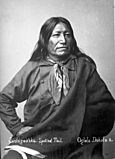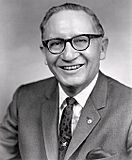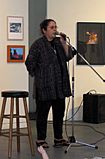Rosebud Indian Reservation facts for kids
Quick facts for kids
Rosebud Sioux Indian Reservation
|
||
|---|---|---|
|
||
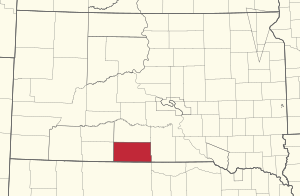
Location in South Dakota
|
||
| Tribe | Rosebud Sioux Tribe | |
| Country | United States | |
| State | South Dakota | |
| Counties | Gregory Lyman Mellette Todd (all) Tripp |
|
| Established | 1889 | |
| Headquarters | Rosebud | |
| Government | ||
| • Body | Rosebud Sioux Tribal Council | |
| Area | ||
| • Total | 5,103.214 km2 (1,970.362 sq mi) | |
| Population
(2017)
|
||
| • Total | 11,354 | |
| • Density | 2.22487/km2 (5.76239/sq mi) | |
| Time zone | UTC-6 (CST) | |
| • Summer (DST) | UTC-5 (CDT) | |
| Website | rosebudsiouxtribe-nsn.gov | |
The Rosebud Indian Reservation (RIR) is an Indian reservation in South Dakota, United States. It is the home of the federally recognized Sicangu Oyate (the Upper Brulé Sioux Nation) – also known as Sicangu Lakota, and the Rosebud Sioux Tribe (RST), a branch of the Lakota people. The Lakota name Sicangu Oyate translates into English as "Burnt Thigh Nation"; the French term "Brulé Sioux" is also used.
The Rosebud Indian Reservation was established in 1889 after the United States' partition of the Great Sioux Reservation. Created in 1868 by the Treaty of Fort Laramie, the Great Sioux Reservation originally covered all of West River, South Dakota (the area west of the Missouri River), as well as part of northern Nebraska and eastern Montana.
Since then, the reservation has been reduced considerably in size, as has happened with the other Sioux reservations. It includes Todd County, South Dakota, and certain communities and lands in the four adjacent counties.
Contents
Geography and population
The RIR is located in south central South Dakota, and presently includes within its recognized border all of Todd County, an unincorporated county of South Dakota. However, the Oyate also has communities and extensive lands and populations in the four adjacent counties, which were once within the Rosebud Sioux Tribe (RST) boundaries: Tripp, Lyman, Mellette, and Gregory counties, all in South Dakota. Mellette County, especially, has extensive off-reservation trust land, comprising 33.35 percent of its land area, where 40.23 percent of the Sicangu Oyate population lives.
The total land area of the reservation and its trust lands is 1,970.362 sq mi (5,103.214 km²) with a population of 10,469 in the 2000 census. The main reservation (Todd County) has a land area of 1,388.124 sq mi (3,595.225 km²) and a population of 9,050. The RIR is bounded on the south by Cherry County, Nebraska, on the west by the Pine Ridge Indian Reservation, on the north by the White River, and originally, on the east by the Missouri River.
The Oyate capital is the unincorporated town of Rosebud, established when the Spotted Tail Indian Agency (named after the 19th-century war chief, whose Lakota name was Sinte Gleska) to the banks of Rosebud Creek near its confluence with the Little White River. It was previously located in northwestern Nebraska. The largest town on the reservation is Mission, served by the intersections of US Highways 18 and 83.
Mission's near neighbor of Antelope is one of the many tribal band communities established in the late 1870s. It has grown since then. Other major towns in the reservation are Saint Francis, located southwest of Rosebud. It is the home of Saint Francis Indian School, a private Catholic institution first established as a mission school. Saint Francis, with a current population of about 2000, is the largest incorporated town in South Dakota without a state highway for access.
Located on the Great Plains, just north of the Nebraska Sandhills, Rosebud Indian Reservation has large areas of Ponderosa Pine forest scattered in its grasslands. Deep valleys are defined by steep hills and ravines, often with lakes dotting the deeper valleys.
Economy and services
Major employers include Rosebud Sioux Tribe, Bureau of Indian Affairs, and Todd County School District. The RST owns and operates Rosebud Casino on U.S. Route 83 just north of the Nebraska border. Nearby is a fuel plaza, featuring truck parking and a convenience store. Power for the casino is furnished in part by one of the nation's first tribally owned wind turbines, which generate electricity. In the early 21st century, the tribe built a new residential development, Sicangu Village, along Highway 83 near the casino and the state line.
The Tribe also owns QCredit, an online financial services company. The Tribe works with financial technology vendor Think Finance for assistance with compliance management, risk management, and loan services.
The Wolakota Buffalo Range is a nearly 28,000-acre native grassland (11,000 ha) for a bison herd on the reservation. The Rosebud Economic Development Corporation (REDCO), the economic arm of the Rosebud Sioux Tribe, is managing the land. Established in 2020, the herd will help develop ecological restoration, cultural practices, economic development, food security and public education.
General information
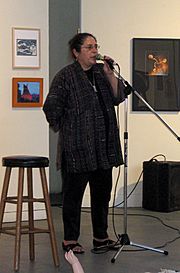
- Land Area: 882,416 acres (3,571.01 km2)
- Tribal headquarters: Rosebud, South Dakota
- Time zone: Central
- Enrolled members living on reservation: 21,245
- Major employers: Rosebud Sioux Tribe, Bureau of Indian Affairs, Todd County School District
Government
Under the Indian Reorganization Act of 1934, the federally recognized Rosebud Sioux Tribe (RST) re-established self-government. It adopted a constitution and bylaws, to take back many responsibilities for internal management from the BIA. It followed the model of elected government: president, vice-president, and representative council, adopted by many Native American nations. At the time and since then, many tribal members opposed the elected government, preferring their traditional form of hereditary clan chiefs selected for life, contingent on approval by women elders, and a tribal council that operated by consensus.
Both women and male elders have continued to have influence within the nation, particularly among those who have followed more traditional lives. At times the political factions have developed and continued along ethnic and cultural lines, with full-blood Sioux following traditional ways. Others, sometimes of mixed-blood or having had more urban or European-American experiences, support the elected government.
The short two-year terms of office can make it difficult for elected officials to carry out projects over the long term. In addition, BIA officials and police retain roles on the reservations, which the historian Akim Reinhardt calls a form of "indirect colonialism".
- Law: charter, constitution, and bylaws (approved November 23, 1935)
- Governing Body: Rosebud Sioux Tribal Council (20 members)
- Executive Officers: President, Vice-President, Secretary, Treasurer, and Sergeant-At-Arms
Elections
- Primary elections, fourth Thursday of August; general elections, fourth Thursday of October
- President and vice-president elected at large for two-year terms; Tribal Council elected from members' districts every two years; Council appoints the secretary, treasurer, and sergeant-at-arms
- Number of election districts: 13
- Proportion of representatives: one representative per 750 members
Council meetings
- Meetings are held twice a month on Wednesday and Thursdays.
- Quorum: Need 11 members
- Aired locally on Goldenwest Channel 93 and Rosebud Sioux Tribe YouTube Channel.
Education
The tribe has developed Sinte Gleska University on the reservation. The tribal university is named after the 19th-century Sioux war chief and statesman, whose name in English was Spotted Tail.
- St. Francis Indian School (Sicangu Oyate Ho, Inc.), in Saint Francis is a private Catholic institution first established as a mission school.
- St. Joseph's Indian School, Chamberlain, South Dakota
- Todd County High School, Mission, South Dakota (Todd County School District 66-1)
- White River School District K-12, White River, South Dakota
- Akta Lakota Museum & Cultural Center, located since 1991 in an adapted 1968 building on the campus of St. Joseph's Indian School.
Notable tribal members and residents
- Notable Rosebud tribal members include:
-
Chief Spotted Tail,
Brulé Lakota Leader -
Ben Reifel "Lone Feather",
U.S. Representative, first Lakota Indian member of Congress. -
Janeen Antoine (Sicangu Lakota), curator, educator, and director of American Indian Contemporary Arts in San Francisco, grew up on the Rosebud Reservation.
- Susan Allen, the first Native American woman elected to the Minnesota state legislature, and the first openly lesbian Native American to win election to a state legislature.
- Janeen Antoine (Sicangu Lakota), curator, educator, and founder in 1983 of the American Indian Contemporary Arts in San Francisco, grew up on the Rosebud Reservation. Her gallery was one of the first in the nation to feature contemporary American Indian art and is important in encouraging new work. She is a co-host of Bay Native Circle, a weekly radio program broadcast on Wednesday evenings on Pacifica Radio station KPFA-FM, Berkeley.
- Martin Brokenleg, is a psychologist and author in the fields of trauma, resilience, and Native American studies. An enrolled member of the Rosebud Sioux Tribe, he was a professor of Native American studies at Augustana University in South Dakota for 30 years.[1] He also served as Professor and Director of the Native Ministries Programme at the Vancouver School of Theology from 2004 to 2009.
- Belva Cottier (1920-2000), activist and social worker who planned the 1964 Occupation of Alcatraz.
- Paul Eagle Star, (1864-1891) (Brulé Sioux), member of Buffalo Bill's Wild West Show
- Troy Heinert (Rosebud Sioux), politician, businessman, and rodeo pick-up rider. He was elected to the South Dakota House in 2012 and to the SD Senate in 2014; he is Senate Assistant Minority Leader
- Chief Iron Shell, led the Brulé Orphan Band during the Powder River War of 1866–1868.
- Joseph M. Marshall III, Lakota historian and writer, winner of the 2008 PEN/Beyond Margins Award for one of his histories
- Terry L. Pechota, American attorney who was the 32nd United States Attorney for the District of South Dakota; nominated by Jimmy Carter, confirmed by United States Senate 1979.
- Benjamin "Ben" Reifel (Rosebud Sioux) (1906-1990), five-term U.S. Congressman, served in the U.S. Army, worked as a field officer and regional administrator for the BIA, and earned master's and doctoral degrees in public administration from Harvard University. Reifel was elected as US Representative in 1960 and served until his retirement in 1971.
- Yvette Roubideaux (Rosebud Sioux), M.D., M.P.H., was Director of the United States Indian Health Service (IHS), appointed in 2009 as the first woman to hold the position.
- Chief Sinte Gleska, translated as "Spotted Tail" (1823-1881), was a war chief and later worked for peace. He was a Brulé Sioux relative of Crazy Horse. In 1868 he signed a peace treaty with the US in 1868 to cede lands. Sinte Gleska University, a Lakota Tribal college, is named for him.
- Richard Twiss (1954-2013), founder of Wiconi International ministry.
- Frank Waln, a Sicangu Lakota rapper
- Albert White Hat Sr.- Author, language teacher, and leader.
- Dyani White Hawk (born 1976), Sicangu artist and former curator of All My Relations Arts gallery
- Chauncey Yellow Robe ("Kills in the Woods") (Canowicakte) (1867-1930), was an educator, lecturer and Native American activist. Raised in the Sicangu Lakota tradition, he was a founding member of the Society of American Indians. He fought for American Indian citizenship during the Progressive Era, and collaborated with American Museum of Natural History to produce silent drama The Silent Enemy, in which he starred as Chief Chetoga.
Communities
The Rosebud Sioux Reservation has 20 communities represented on its tribal council:
- Antelope
- Okreek
- Parmelee
- Rosebud
- Saint Francis
- Spring Creek
- Two Strike
- Milks Camp
- Corn Creek
- Butte Creek
- Soldier Creek
- Upper Cut Meat
- Ring Thunder
- Black Pipe
- Bull Creek
- Swift Bear
- Grass Mountain
- Ideal
- He Dog
- Horse Creek
See also
 In Spanish: Reserva india Rosebud para niños
In Spanish: Reserva india Rosebud para niños



